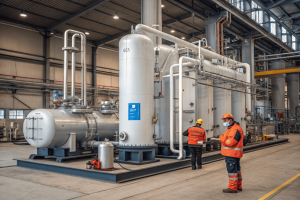What is the 'dry ice' or 'frosting' challenge in cryogenic CO2 capture, and how is it mitigated?
•
What is the 'dry ice' or 'frosting' challenge in cryogenic CO2 capture, and how is it mitigated?
Cryogenic capture promises ultra-pure CO₂, but the extreme cold is a huge problem. You worry that freezing CO₂ will clog your entire system, causing a catastrophic failure and shutdown.
The 'frosting' challenge is when CO₂ turns into solid dry ice on cold surfaces, blocking pipes and heat exchangers. This is mitigated by precise temperature and pressure control, multi-stage cooling designs, and sometimes using anti-freeze agents or systems designed for solid-vapor separation.

I've seen cryogenic systems that look beautiful on paper. The thermodynamics are elegant. But in practice, you are fighting against a fundamental property of carbon dioxide. If you are not careful, you will end up building a very expensive, very effective ice machine that clogs itself solid. Managing this phase change from gas to solid is the single biggest engineering challenge in this technology. Understanding this requires moving beyond simple diagrams and looking at the real-world operational difficulties that frosting can cause.
How do flue gas impurities, such as SOx and NOx, affect the stability and performance of amine solvents?
Your amine solvent performance is degrading faster than expected. You keep having to add fresh solvent, and your operating costs are climbing. The problem lies in the flue gas you're treating.
SOx and NOx react irreversibly with the amine to form heat-stable salts. These salts are "dead" amine that can no longer capture CO₂. This reduces the system's capacity, increases energy demand, and accelerates solvent degradation and corrosion.

I always tell my clients that an amine system is only as good as the gas it's fed. You can't just connect a capture unit to a raw flue gas stream and expect it to work long-term. SOx and NOx are like poison to the amine. They don't just participate in a reversible reaction like CO₂; they create a permanent chemical bond. This creates a cumulative problem where the solvent gets progressively less effective over time. Proper flue gas pretreatment isn't an optional add-on; it's an absolute necessity for the health of your plant.
The Chemistry of Degradation
The core issue is that SOx and NOx are strongly acidic gases. They react with the basic amine solvent in a way that the heat from the reboiler cannot reverse.
Pretreatment is Key
The best way to manage these impurities is to remove them before they ever reach the amine absorber.
- Sulfur Oxides (SOx): These are typically removed using a pre-scrubber, often a caustic soda (NaOH) wash. This step protects the amine from the most aggressive form of degradation.
- Nitrogen Oxides (NOx): These are more difficult to scrub. The best approach is often to reduce their formation at the combustion source or use a Selective Catalytic Reduction (SCR) unit upstream.
| Impurity | Chemical Reaction Product | Impact on System | Mitigation Strategy |
|---|---|---|---|
| SOx | Heat-Stable Salts (HSS) | Reduces capacity, increases viscosity and corrosion. | Caustic Scrubber |
| NOx | Nitrosamines, HSS | Forms harmful compounds, reduces capacity. | SCR unit, combustion control |
| Oxygen | Oxidative Degradation | Breaks down amine molecules, increases corrosion. | Use of inhibitors |
Without these upstream protections, the build-up of heat-stable salts will force you to run the reclaimer unit more often and eventually require a complete replacement of the expensive solvent.
What is the current state of research for solid adsorbents (e.g., MOFs) in improving the efficiency of CO2 capture?
Pressure Swing Adsorption (PSA) works, but its standard materials have limitations. You're looking for the next breakthrough technology that offers higher capacity and better selectivity, reducing energy costs and system size.
Current research focuses on advanced materials like Metal-Organic Frameworks (MOFs) and zeolites. These engineered materials have incredibly high surface areas and can be tailored to capture CO₂ selectively, promising to make PSA systems more efficient and compact.
")
The adsorbent materials we use today, like activated carbon and standard zeolites, are amazing. They are the workhorses of the industry. But as engineers, we are always pushing for better. The research into materials like MOFs is incredibly exciting. Imagine a material that is like a molecular sponge, with pores that are perfectly shaped to grab CO₂ molecules and let everything else pass by. That's the promise of these new adsorbents. While they are still mostly in the pilot stage and face challenges with cost and long-term stability, they represent a huge leap forward for the efficiency of physical separation processes.
The Next Generation of Adsorbents
The goal of this research is to create a material that can capture more CO₂ with less energy input for regeneration.
Why MOFs are Promising
Metal-Organic Frameworks are a class of crystalline materials constructed from metal ions linked by organic molecules. This structure creates a very high internal surface area.
- High Capacity: Some MOFs have a surface area equivalent to a football field packed into a single gram of material. This means they can hold much more CO₂ than traditional adsorbents.
- Tunable Selectivity: Researchers can change the metal and organic components to "tune" the pore size and chemical affinity, making them highly selective for CO₂ over other gases like nitrogen.
| Adsorbent Type | Key Advantage | Current Challenge |
|---|---|---|
| Zeolites (Traditional) | Proven, robust, cost-effective | Limited capacity, sensitive to water |
| Metal-Organic Frameworks | Extremely high capacity, tunable selectivity | High cost, long-term stability, water sensitivity |
| Solid Amines (Functionalized) | High selectivity, low regen temp | Lower capacity, can degrade with cycling |
The ultimate goal is to find or create an adsorbent that achieves the "sweet spot" of high capacity, high selectivity, durability, and low manufacturing cost.
Explain the concept of 'hybrid CO2 capture systems' and why they are being developed.
You have a complex gas stream, and no single capture technology is a perfect fit. Membranes are good for bulk removal but not purity. Solvents offer high purity but are energy-intensive.
Hybrid systems combine two or more different capture technologies in a series. This allows each technology to operate in its most efficient range, leading to lower overall energy consumption and capital costs compared to a single-technology approach.

In my work, I've seen that there is no "one size fits all" solution for CO₂ capture. Sometimes the best answer is to not choose just one technology, but to combine the strengths of several. For example, we might design a system that uses a relatively cheap membrane unit to do the "heavy lifting" and remove 80% of the CO₂, enriching the stream. Then, that smaller, CO₂-rich stream is fed to a more expensive but highly efficient amine or cryogenic unit to achieve the final 99.9%+ purity. This approach lets each technology do what it does best.
The Best of Both Worlds
Developing hybrid systems is about optimizing the entire process, not just one unit operation.
A Common Hybrid Example: Membrane + Cryogenic
Let's look at how this popular combination works.
- Stage 1: Membrane Unit: The raw, low-concentration flue gas is sent through a membrane system. The membranes separate the gas into two streams: one mostly nitrogen stream that is vented, and another stream that is now enriched with CO₂ (e.g., from 15% up to 60%). The membrane unit is very efficient for this bulk separation task.
- Stage 2: Cryogenic Unit: This smaller, CO₂-rich stream is now sent to a cryogenic system. Because the volume of gas is much smaller and the CO₂ concentration is higher, the cryogenic unit can be drastically smaller and requires far less energy to achieve the final liquefaction and purification to >99.9%.
This combination can offer significant advantages over using either technology alone for the entire job.
Conclusion
Managing CO₂ frosting is key for cryogenic systems. Amine health depends on clean gas. New materials and hybrid systems are pushing the boundaries of what is possible in CO₂ capture technology.
You may also be interested in:

Why is CO₂ recovery technology gaining popularity worldwide?
Why is CO₂ recovery technology gaining popularity worldwide? You see headlines about carbon capture everywhere. But you wonder if it's
Read more
How is a CO₂ recovery system designed to fit different industries?
How is a CO₂ recovery system designed to fit different industries? You're under pressure to implement a CO₂ recovery solution.
Read more
How energy-efficient are today’s CO₂ recovery technologies?
How energy-efficient are today’s CO₂ recovery technologies? You want to recover CO₂, but you fear that high electricity bills will
Read more